The Air Force and Its Academy–Legends Who Brought Vision to Reality
On the Air Force’s 75th Anniversary, A Look at Academy Building Namesakes’ Roles
Lieutenant Colonel (Retired) Steven A. Simon, USAFA Class of 1977
|
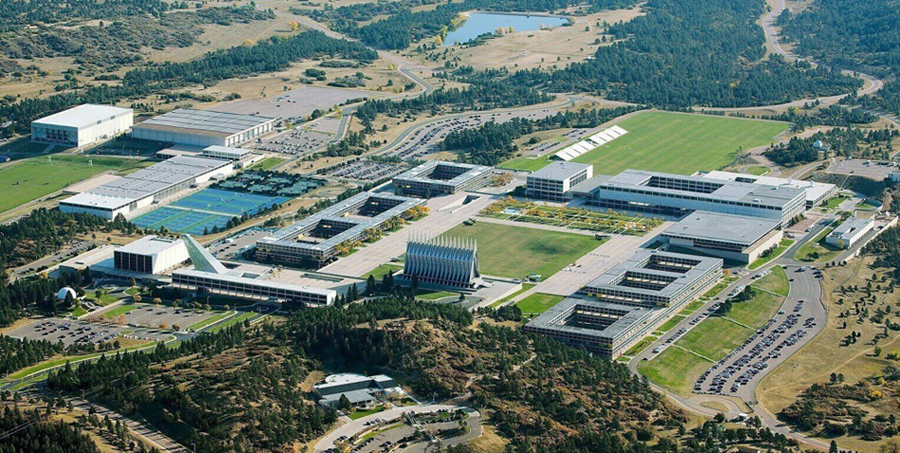 |
Some of the Air Force Academy’s facilities, including the distinctive aluminum and glass buildings in the Cadet Area and the Academy airfield are named for aviation pioneers who were extremely influential in making the case for an air academy. Interestingly and perhaps not surprisingly, these leaders were also vitally important in the struggle for the independent United States Air Force, which commemorates its 75th anniversary this month.
In fact, some of them were advocating for both institutions at the same time.
As we commemorate the Air Force’s three-quarters-of-a-century milestone, it is appropriate to reflect on those who willed the separate service into being. Much of the credit for the Air Force’s founding, not to mention the establishment and early development of the fledgling service’s Academy, can be directed toward seven individuals whose familiar names grace Academy facilities: Mitchell, Arnold, Vandenberg, Fairchild, Harmon, Davis, and McDermott.
|
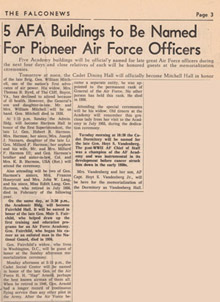
Falconews, June 1959
|
William "Billy" Mitchell
The United States entered World War I very late, and with only a few American-built planes. Some Americans did, however, see aerial action during the European “war to end all wars.” Among those was William “Billy” Mitchell, namesake of the cadet dining hall and exemplar for the Class of ’01. He was one of the early American aviators who learned from his wartime experiences and observations and became a strong advocate for a separate air service and academy.
Col. (Ret.) Walter Boyne, noted combat veteran, aviation historian, and author, writes in “Beyond the Wild Blue: A History of the U.S. Air Force, 1947-1997,” that, even as far back as 1916, “Mitchell was already promoting the concept of an independent air force.”
On Apr. 30, 1917, Maj. Mitchell earned the distinction of being the first American officer to fly over the German lines, which he did as an observer in a French aircraft.
After the conclusion of World War I, on Apr. 16, 1919, he sent a memorandum to Major General Charles Menoher, Director of the Air Service, advocating for an air academy. Mitchell wrote, “While it is desirable that the academy be located near a flying field, it is not essential that the students be able to fly to any great extent during their course of instruction.” He recommended the Academy be established at Dayton, Ohio.
On Jan. 25, 1925, after proving the value of airpower by sinking several ships, including the captured German battleship Ostfriesland, Gen. Mitchell testified on Capitol Hill. He said it was “most essential . . . to have an air academy to form a basis for the permanent backbone of your air service and to attend to the . . . organizational part of it, very much in the same way that West Point does for the Army, or the Naval Academy for the Navy.”
In words and actions, he forcefully made the case for the importance of airpower, and by extension the need for an independent Air Force with its own Academy. Too forcefully as it turned out. On Sept. 5, 1925, after two deadly incidents featuring Navy aircraft, he spoke to the press, saying, “These incidents are the direct result of the incompetency, criminal negligence, and almost treasonable administration of the national defense by the Navy and War Departments.”
His superior officers did not appreciate such candor. He was charged with insubordination for his comments and on Oct. 28, 1925, his court-martial began. Despite a series of distinguished character witnesses testifying on his behalf, to include Henry “Hap” Arnold, Carl Spaatz, and Eddie Rickenbacker, on Dec. 17, 1925, he was found guilty of all specifications. The panel sentenced Mitchell to a suspension from rank, command, and duty, with forfeiture of all pay for five years.
His retirement on Feb. 1, 1926, marked the end of his military career, but not his influence.
Phillip Meilinger ’70 has written that Mitchell saw the election of Franklin Roosevelt as positive for air power. In 1932, Mitchell shared his thoughts on the organization of the military services with the President-Elect. There was speculation that he might obtain a senior position in the Roosevelt Administration, perhaps even Secretary of War, but that did not transpire.
Events and the passage of time proved the validity of many of Billy Mitchell’s arguments regarding airpower. His reputation was eventually restored, and his Air Force and Air Force Academy advocacy bore fruit. Unfortunately, that took place long after his 1936 passing.
|
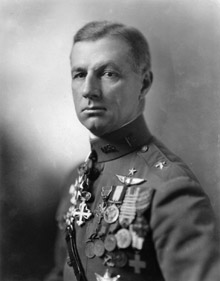
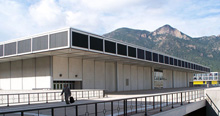
Mitchell Hall
|
Henry "Hap" Arnold
The aviation career of Henry Arnold, namesake of the Cadet Area’s social center and exemplar for the Class of ’12, quite literally goes back to the very beginning of powered flight. He was taught to fly by none other than the Wright Brothers themselves. Arnold earned his wings in 1911 at their flying school at Simms Station in Dayton, Ohio.
In 1912, when the War Department issued Bulletin Number 2 creating a “Military Aviator” rating, 1 Lt. Arnold was among the first to receive the “silver wings.”
His flying career was not without turmoil, however, including a November 1912 incident at Fort Riley, Kansas, when his Wright Model C biplane very nearly crashed. Col. Boyne recounts what happened next: “Arnold assessed the situation and realized that the aircraft he was being asked to fly were intrinsically and unreasonably dangerous. Summoning all of his moral courage, aware that his action would be criticized, he admitted to a fear of flying and requested reassignment. It was granted, and he did not return to aviation until 1916, and then at the specific request of Major William “Billy” Mitchell, Chief of the Signal Corps’ Aviation Section.”
Back on track, Arnold became a strong supporter of the air service. On Jun. 6, 1918, Maj. Arnold was the Assistant Director of Military Aeronautics. In that capacity, he sent a memorandum to the newly appointed Chief of the Air Service, Brigadier General William Kenly, expressing the need for the air arm’s independence.
As he gained rank and responsibility leading up to and during World War II, Arnold’s words and actions advanced the cause of air power. He served as the Chief of the Air Corps, then Chief of the Army Air Forces and eventually the Commanding General of the Army Air Forces. Beginning in 1938, he directed air activities for the nation, a role he held throughout the global war against Germany and Japan.
On Dec. 21, 1944, Arnold was promoted to the grade of General of the Army. He was the fourth officer to attain this five-star rank, joining George Marshall, Douglas MacArthur, and Dwight Eisenhower. He was unique, however, as the only airman to be so honored.
Boyne declares, “One man, Henry Harley Arnold, did the most to shape the image of the modern United States Air Force. His patient political spadework established trust with the United States Army brass and secured the essential patronage of General George C. Marshall, the Chief of Staff.”
Arnold’s official Air Force biography states that “his life paralleled the growth of America’s air power and he personally contributed to most of the major milestones of development during the long period until he retired in 1946.”
Heart issues forced that retirement, but the nation continued to recognize and reward his outsized contributions. On May 7, 1949, he was appointed as the first General of the Air Force, five-star rank, by Congress. That advancement in grade gave him the distinction of being the only officer to hold five-star rank in two U.S. military services.
|
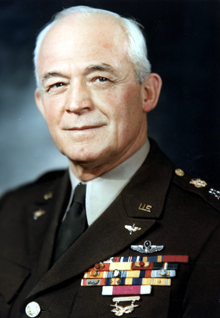
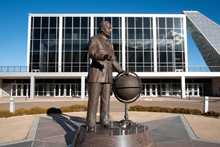
Arnold Hall
|
Hoyt Vandenberg
As World War II ended, Gen. Hoyt Vandenberg, namesake of the Academy’s original cadet dormitory, was already one of Gen. Arnold’s most trusted advisors. During the conflict, he had flown missions during the Northern African campaign, and served in several leadership positions, to include Commander of the Ninth Air Force and Assistant Chief of Air Staff at Air Corps headquarters.
When President Harry Truman asked the services to plan for the post-war timeframe, Arnold selected Vandenberg to be on the Army Air Force’s task force, along with luminaries such as Gens. Ira Eaker, Carl Spaatz, and Lauris Norstad. Unfortunately, the massive demobilization of the armed forces at the conclusion of World War II prevented many of their plans from being enacted, but Vandenberg’s career continued on its upward trajectory.
On the first day of October 1947, he became the Air Force’s first Vice Chief of Staff, with a promotion to four-star general.
A few months later, on Apr. 30, 1948, Gen. Vandenberg became the Air Force’s second Chief of Staff, succeeding Gen. Spaatz. Vandenberg held the position until the end of June 1953. It was a trying time, as he was forced to defend the nation and execute the air war in Korea with what he called “a shoe-string Air Force.”
Despite those difficulties, he almost immediately went to work on the Academy concept. There was concern about the number and the training of the officers the Air Force was getting from the other academies. There was also a natural desire to move away from the Army, its former host service, and having its own academy would further that objective.
In September 1948, Gen. Vandenberg responded to the Fairchild Board, which was studying a potential Air Force Academy. He wrote that he wanted a plan “based upon a four-year course of instruction generally along the line of the present service academies.”
As momentum built for an academy, Gen. Vandenberg established the Office of Special Assistant for Air Force Academy Matters. He selected Lieutenant General Hubert Harmon as its head.
Gen. Vandenberg not only wanted an Academy, but he also had thoughts on where it should be located. On Oct. 31, 1951, the Colorado Springs Gazette Telegraph quoted him as saying, “Colorado Springs is a nice spot and I would like to see it designated as the future site of the Air Academy.”
He retired at the end of his second term as Chief of Staff of the Air Force on June 29, 1953 and, sadly, died at the age of 55 on Apr. 2, 1954, exactly one day after the Academy was established.
Two decades later, his son would join him in the ranks of Air Force general officers, eventually rising to the rank of Major General. Most notably, he linked the Air Force’s past with its present as the Commandant of Cadets at the Academy from 1973 to 1975.
|
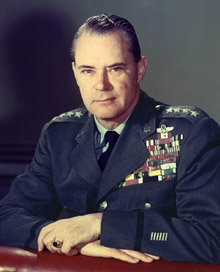
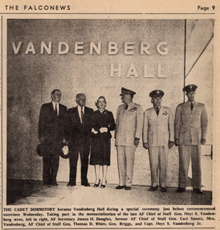
Falconews, June 1959

Vandenberg Hall
|
Muir Fairchild
As might be expected for the namesake of the Academy’s academic building, Gen. Muir Fairchild’s most lasting and noteworthy contribution to the Air Force was in the field of education. He was responsible for the development of much of the Air Force’s initial academic program. That work included early efforts to develop the Academy’s eventual curriculum.
During World War II, Gen. Fairchild was the Secretary of the newly formed Air Staff and then the Assistant Chief of the Air Corps. In January 1946, he was named commandant of Air University at Maxwell Field in Alabama, with promotion to lieutenant general.
In May 1948, less than a month after Gen. Vandenberg ascended to the role of Chief of Staff, Gen. Fairchild became the second vice chief of staff of the U.S. Air Force, succeeding Vandenberg.
In August 1948, at the request of Secretary of the Air Force, W. Stuart Symington III, Gen. Fairchild chaired a conference of fifteen civilian educators and key military officers tasked to establish guidelines for an air academy. The Fairchild Board, as the group was named, proposed two courses of action. The first was a five-year program with the first two at a civilian college or university, with expenses paid by the Air Force, followed by three years at a military institution. This was labelled the “composite plan.” The second option, the “conventional plan,” called for four years at a military institution. A majority of the board preferred the composite plan.
General Vandenberg did not concur, favoring the conventional plan. He did, however, agree with the Fairchild Board’s recommendation that pilot training should not be accomplished at the Air Force Academy. In addition, he assigned the responsibility for Air Force Academy to the organization Gen. Fairchild had helped build, Air University.
While Gen. Fairchild was instrumental in the development of the Academy’s curriculum, he did not live to see the fruits of his labor. He died on Mar. 17, 1950, at Fort Myer, Virginia., while still on active duty as Vice Chief of Staff of the Air Force. Coincidentally, like Gen. Vandenberg, he was 55 years old.
|
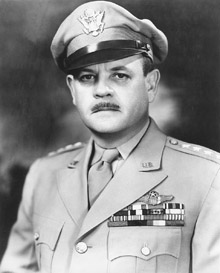
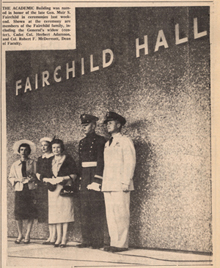
Falconews, June 1959

Fairchild Hall
|
Hubert Harmon
Hubert Harmon had a distinguished career before becoming forever associated with the Academy. A 1915 graduate of West Point, he served overseas during both world wars. In late 1943, Lt. Gen. Harmon was made Deputy Commander for the Air Forces of the South Pacific Area, and in January 1944 he assumed command of the 13th Air Force in that area. He was subsequently appointed Commander of the 6th Air Force, which was later redesignated the Caribbean Air Command.
At the time of the Air Force’s establishment, Gen. Harmon was one of its most senior officers.
As he rose through the ranks of the Air Force’s predecessor organizations, however, his long and distinguished career featured several seemingly coincidental brushes with academia in general and the future Academy in particular.
In September 1917, he was assigned to Kelly Field, Texas, where he organized and served as commandant of the Ground Officer’s Training School.
After World War I assignments in France, Germany, and England, in 1920, Capt. Harmon transferred to the Air Service. Two years later, as the Assistant Executive in the Office of the Chief of the Air Service, Maj. Harmon wrote to the Chief of the Engineering Division at McCook Field in Dayton, Ohio, regarding a Senate Resolution to study the feasibility of an air academy.
The Army was doing all it could to resist having a separate air service, including taking some steps to accommodate the needs of flyers. Jeffrey Stamp ’92, in an article he wrote for the Military History Symposium-sponsored book “High Flight: History of the U.S. Air Force Academy,” writes that, “In 1929, West Point requested funds from Congress to buy additional acreage for artillery and aviation training: the request was granted in 1931. Incidentally, the officer who surveyed the land in question and recommended its purchase was Major Hubert Harmon, the future first USAFA Superintendent.”
As the years went on and the Air Force became a reality, none of the Academy building namesakes had a more direct role in the Academy’s founding than Gen. Harmon.
On Dec. 19,1949, Gen. Vandenberg put Harmon in charge of the newly established Office of Special Assistant for Air Force Academy Matters in Washington D.C.
Twice in 1953, Harmon retired from the Air Force. In both instances, there was concern that in his absence the Academy office lacked sufficient stature and power, and he was recalled to active duty. The second time was at the personal request of President Dwight Eisenhower, Harmon’s West Point classmate.
In the Special Assistant position, Harmon fought for the Academy against all sorts of opposition. It was sometimes frustrating work, as evidenced by a Feb. 10, 1954, letter to General Frederick Smith Jr., in which Harmon wrote, “The only real problem in this whole Academy project is where to put it. It reminds me of the centipede which lay distracted in the ditch considering how to run. It begins to look as though we will never have an Academy because of inability to resolve this question.”
Fortunately, that and all other issues were finally resolved. On Aug. 14, 1954, Gen. Harmon signed General Order Number 1, ESTABLISHMENT OF THE UNITED STATES AIR FORCE ACADEMY, and assumed command of the institution.
Unlike many of his fellow Air Force and Air Force Academy pioneers, he lived to see his efforts to establish an air academy come to fruition, though he passed away before the first class graduated. Fittingly, he was the first person buried at the Air Force Academy Cemetery.
Also fittingly, on the occasion of the Academy’s 50th anniversary on 1 April 2004, he was named “The Father of the U.S. Air Force Academy.”
|
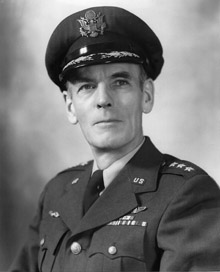
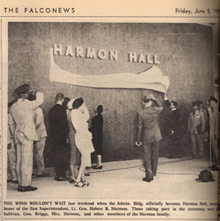
Falconews, June 1959
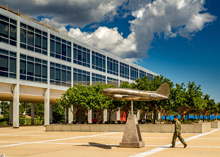
Harmon Hall
|
Benjamin O. Davis Jr.
Benjamin O. Davis Jr., namesake of the Academy’s airfield, was an aviation pioneer and a trendsetter. Through his example, leadership, and personal courage in overcoming racism, he helped set the stage for an independent air service, and then strove tirelessly to make it better and more equitable.
Davis followed his father into the military and into the infantry. In the early 1940s, World War II raged overseas, and U.S. leaders began planning for a possible entry into the conflict. That preparation included the anticipated need for pilots.
On February 1941, then-Captain Davis received orders to report to Tuskegee, Alabama, where a new Army airfield was being established.
On March 7, 1942, Davis and four classmates became the first five African Americans to graduate from pilot training. As the senior member of the group. Capt. Davis was likely the first to have the military pilot badge pinned on his chest.
Not even two years later, then-Lt. Col. Davis became the first African American fighter group commander. He would also command a major air base and a wing, as well as the Tuskegee Airmen, with whom he flew 60 World War II combat missions in the distinctive fighters with red tails.
With the Air Force established in 1947, Col. Davis had much more work to do to improve the nation’s newest military organization. The following year, President Harry Truman signed an executive order integrating the U.S. armed forces.
Sherman Fleek, U.S. Military Academy command historian, writes that the Air Force “had already taken steps toward integrating it [sic] segregated units, and much of the process and vision was due to Col. Davis and the Tuskegee Airmen based on their World War II record . . . Col. Davis also served on the U.S. Air Force staff developing an integration policy.”
He continued to break new ground and improve the situation for those around him. He was the first African American to attend the Air War College at Maxwell Air Force Base in Montgomery, Alabama, graduating in 1950. Upon that graduation, Fleek writes, “Col. Davis reported to the Pentagon to serve as staff planning officer of the deputy chief of staff for operations, HQ USAF. While there, Davis conceived the idea to create a ‘precision flying team’ with jet fighters that would go around the country conducting air shows and demonstrations for the public.” In 1953, that vision became reality with the establishment of the Thunderbirds.
On Oct, 27, 1954, Davis became the first African American general officer in the U.S. Air Force. Remarkably, 14 years earlier, his father, Benjamin O. Davis Sr., had become the first African American general officer in the U.S. Army. Gen. Davis retired in 1970, but continued serving, including as the chairman of the USAFA Board of Visitors.
Speaking at the Nov. 1, 2019, dedication of the Davis Airfield, then-USAFA Superintendent, Lt. Gen. Jay Silveria ’85 addressed some of his other contributions, particularly at the Academy.
“Gen. Davis was really instrumental in driving this institution toward a much more diverse and a much more inclusive population,” he said, “and crucial in developing the plan to integrate women at the United States Air Force Academy. To that, we truly owe a legacy here at the Air Force Academy.”
|
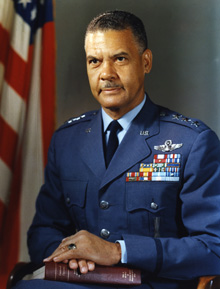
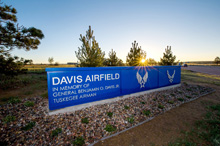
|
Robert McDermott
Robert McDermott, namesake of the Cadet Library located in Fairchild Hall, was only peripherally involved in the establishment of the separate Air Force, given his youth. Still, he was an Air Force trendsetter even before he graduated from the United States Military Academy.
On Jul. 1, 1942, in response to the need for flyers in World War II, West Point began a new course blending pilot training with the regular Academy program. Cadet Robert McDermott, future Dean of the Faculty at the Air Force Academy, was among the first students, called “Air Cadets,” to volunteer for the program. Incidentally, Gen. Arnold was one of the program’s most influential and enthusiastic advocates.
Within months of his January 1943 graduation from West Point, McDermott was in the European Theater, where he flew 61 World War II combat missions in the P-38. He also served as operations officer of a fighter-bomber group in Europe, and was a staff officer in the Pentagon.
After graduating from Harvard Business School in 1950, he had a tour on the West Point faculty in the Department of Social Science.
In 1954, Col. McDermott reported to Lowry Air Force Base in Denver to become the vice dean and professor of economics at the soon-to-open Air Force Academy. Two years later, he was promoted to Dean of the Faculty, a position he held until his retirement in July 1968. When promoted to the grade of brigadier general in 1939, at 39 years old, he became the youngest flag officer of any service on active duty at that time.
Shaking off the bonds of his West Point background, he looked at the Air Force Academy’s programs with open eyes and an open mind, in the process revolutionizing how military students were educated.
Among Gen. McDermott’s first contributions was to the admissions process. Gen. Harmon had put him in charge of the Admissions Criteria Committee that would determine how prospective cadets were selected. At other academies, appointments were issued almost exclusively on academic merit, but McDermott wanted to broaden that limited scope. He developed an admissions composite that included extracurricular activities, leadership in those activities, and aptitude for flying vocations. Like most of his innovations, this “whole man” approach to choosing students would eventually be implemented at the other academies.
He also worked for years, through and against the bureaucracy, to secure approval for the Academy to offer advanced classes and award master’s degrees. In this endeavor, he was unsuccessful, although he did make other arrangements for graduates to continue their studies.
Gen. McDermott also led the Academy’s efforts to attain accreditation, which was received on April. 24, 1959, making the Academy the only school to receive accreditation before graduating even one class of students.
These seven individuals are richly deserving of their recognition at the Academy based solely on their contributions to the founding and development of the Air Force Academy. As the Academy’s parent service celebrates its 75th anniversary, it is important to give a thought to the roles these incomparable leaders played in creating the United States Air Force. They brilliantly navigated a series of challenges from the other services and national leadership and piloted the new service to its independence.
Even if they’d done nothing else, though, their work in establishing an institution that expertly supplies the Air Force with leaders of character would merit appreciation and respect.
This essay originally appeared in the September 2022 Checkpoints magazine.
|
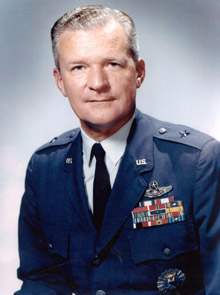
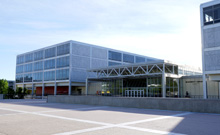
McDermott Library
|





